BHIMASHANKAR is counted as the sixth among the twelve jyotirlingas in India. Jyotirlingas are the places where Lord Shiva is said to have appeared as a column of light, without beginning or end. The temples housing these jyotirlingas hold a special place in the hearts of devout Hindus, and a visit to all the 12 jyotirlingas in the exact order, is a lifetime wish for many.
History, Hinduism, Faith & Adventure prompted me to do some basic research about Bhimashankar before visiting the place. Vedic history states that there was a huge demon named Tripurasur who lived during the Tretayug in the forests of Dakini near Bhimashankar. Given his huge size, he was also called Bheema (not to be confused with the Pandava, Bhima). Tripurasur performed severe penances and when Lord Shiva was pleased, He appeared before him. Tripurasur sought the boon of immortality which Shiva granted him saying ‘no human being or devata could kill him’. Armed with this power of immortality, Tripurasur let loose a reign of terror across the three worlds (Swarglok, Bhulok & Paatal lok). The devatas rushed to Shiva and pleaded with Him to save them. Shiva sought the help of his consort Parvathi, took the Ardhanari form and after a fierce battle killed Tripurasur, bringing peace to all three worlds. The heat of the battle was so intense that the devatas started sweating and this led to the formation/restoration of the Bheema river which had evaporated. The devatas requested Shiva to stay here, which He agreed to, and manifested as a jyotirlinga and said His name should be prefixed with ‘Bhima’, hence Bhimashankar.
Another legend has it that Bhima was Kumbhakarna’s son who lived in the forests here. When he learnt that his father was killed by Lord Vishnu in an earlier avatar, he vowed revenge. He performed severe penances to please Brahma, who blessed him with immense strength. Bhima started terrorizing the world and forcing people to pray to him. An ardent devotee of Shiva, Kamrupeshwar was praying before a Shivling, when Bhima appeared and with a sword attempted to destroy the Shivling. It was than that Lord Shiva appeared before him and reduced him to ashes. Later Lord Shiva is said to have manifested Himself at Bhimashankar as a jyotirlinga.
Cut to the present. We set off by road one cool winter morning from Mumbai. Yes, there was smog in the air as we started. There are two routes to reach Bhimashankar by road from Mumbai. We opted for the Mumbai-Pune Expressway.
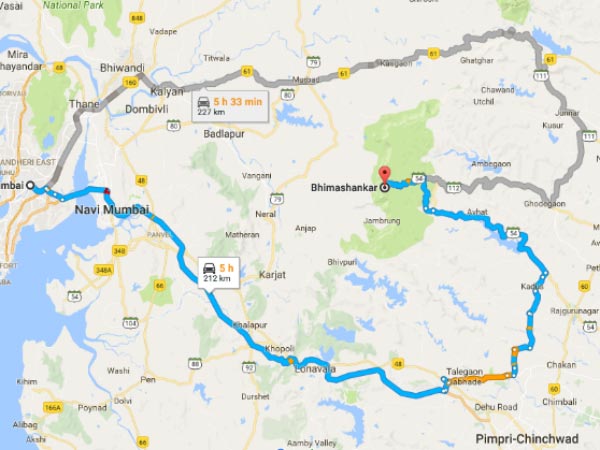
It was business as usual on this route — the time taken to hit the expressway, the cruise on the expressway, the halt at the food-court after Khalapur toll plaza for steaming plates of kaanda poha, sabudana khichdi & masala tea, the small catnap post-breakfast ….. till we reached the Talegaon toll plaza. Here we veered away from the Pune route and took the Talegaon exit towards MIDC. Not much of traffic on this road. The area looked quite deserted too. After a drive for about an hour, the road became narrower — single road, though the condition was very good. A word of caution — if your vehicle works on CNG, please tank- up, as there is only one fuel pump at Talegaon providing the same. Slight incline as we gradually made our way to higher elevation. Greenery on both sides (should be absolutely amazing during the monsoon or immediately after) and we could see a number of windmills on the hills.
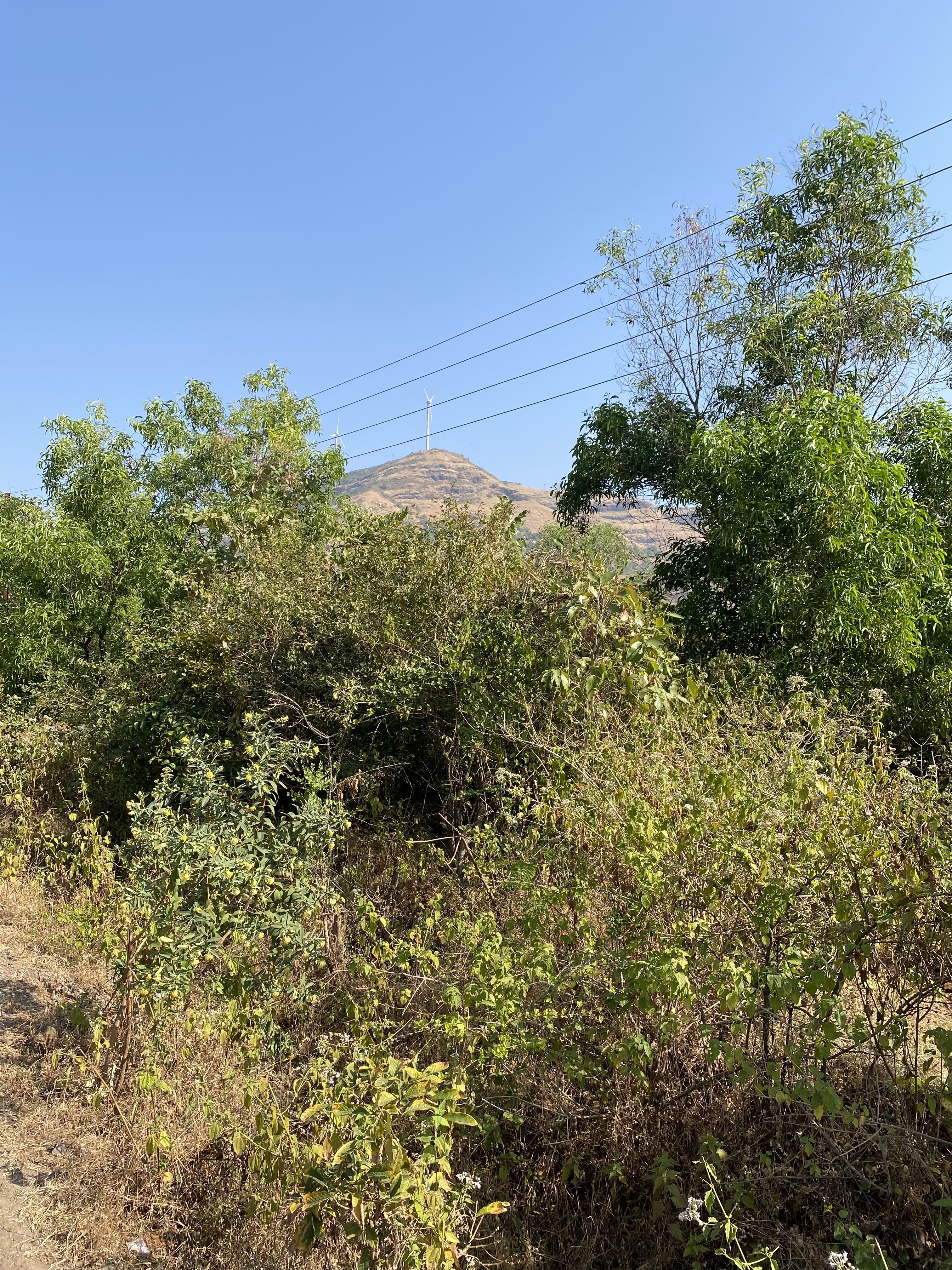
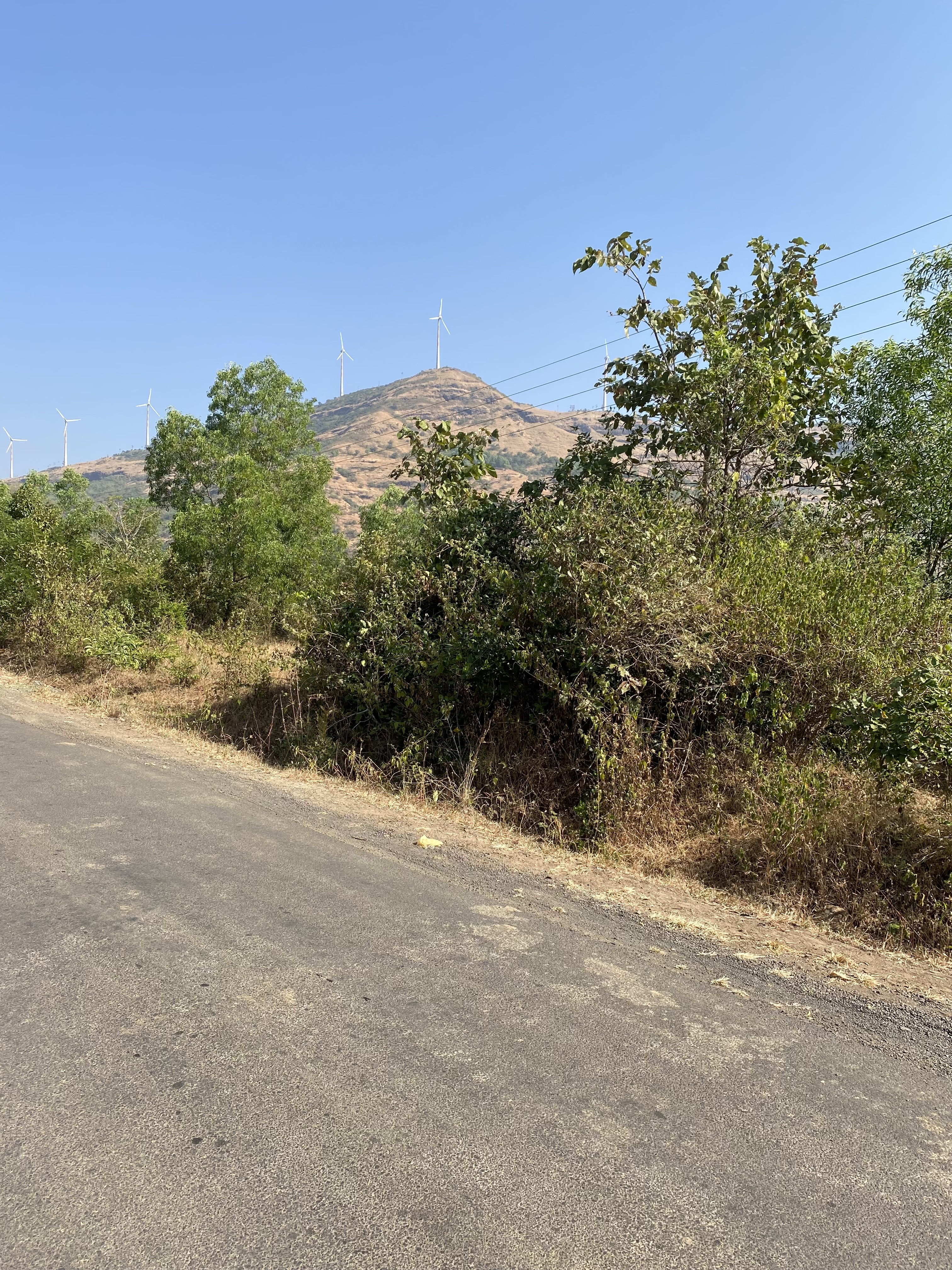
We were climbing even higher now and the beautiful sights of rural Maharashtra lay before us — hills, small valleys, settlements too small to be called villages, too big to be called hamlets were aplenty. larger villages where life was moving at a leisurely pace — some menfolk just sitting with blank stares, doing nothing but watching the world go by; children with bags slung over their heads /shoulders trudging almost reluctantly to school; huge buffaloes with shiny black hides (in Mumbai we see smaller versions with poor skin tones); womenfolk busy carrying pots of water and as our car passes through a narrow stretch, we see the woman of the house washing clothes in a small plastic tub. We passed small tea-stalls, shops-cum-houses, the odd co-operative bank branch and the even rarer State Transport buses coming down from the opposite direction, but absolutely no signboards or milestones to guide us. It was GPS all the way. Wait a minute, just now I see a small sign with an arrow pointing to Bhimashankar. A few more arrows and signs cropping up now. We had been on the road for a little more than five-and-half hours and now we reached a small cabin which was the entrance to Bhimashankar town. Had to pay an entry fee of Rupees fifty and we moved forward. Not for long. There appeared to be a traffic jam on the narrow hill road. Vehicles in front had stopped (we had not seen any en route. Maybe they were coming from the Pune side) and some good Samaritans (??) were. seen regulating the traffic. Soon we realized that they were not good Samaritans, but part of a well-oiled machinery out to make a fast buck.
We were informed that the temple was 1.5 kilometers away but there was no parking space up there and all vehicles had to be left at the side of the road where we were now. No space to move forward. So how to reach the temple? Ha, the guys would take us on motor-bikes one at a time for Rs.500 per head, arrange darshan at the temple for which the fee was Rs.500 again and we would be dropped back near our car. When we did not show interest and preferred to walk to the temple, they came down to Rs.400 per head. Just ignored them.
After a brisk walk, passing a number of cars parked on one side of the road, we soon reached the destination. Small stalls selling juice, tea, snacks are available near the bus-stand, which was empty. We could see a large parking lot, which too had a lot of open spaces. We were at the path which would lead us down to the temple. Yes, the temple is at a lower level and we had to walk along the covered path lined with broad steps. On both sides are small stalls selling puja materials, flowers, etc and also volunteering to take care of your footwear, provided you buy stuff from them.
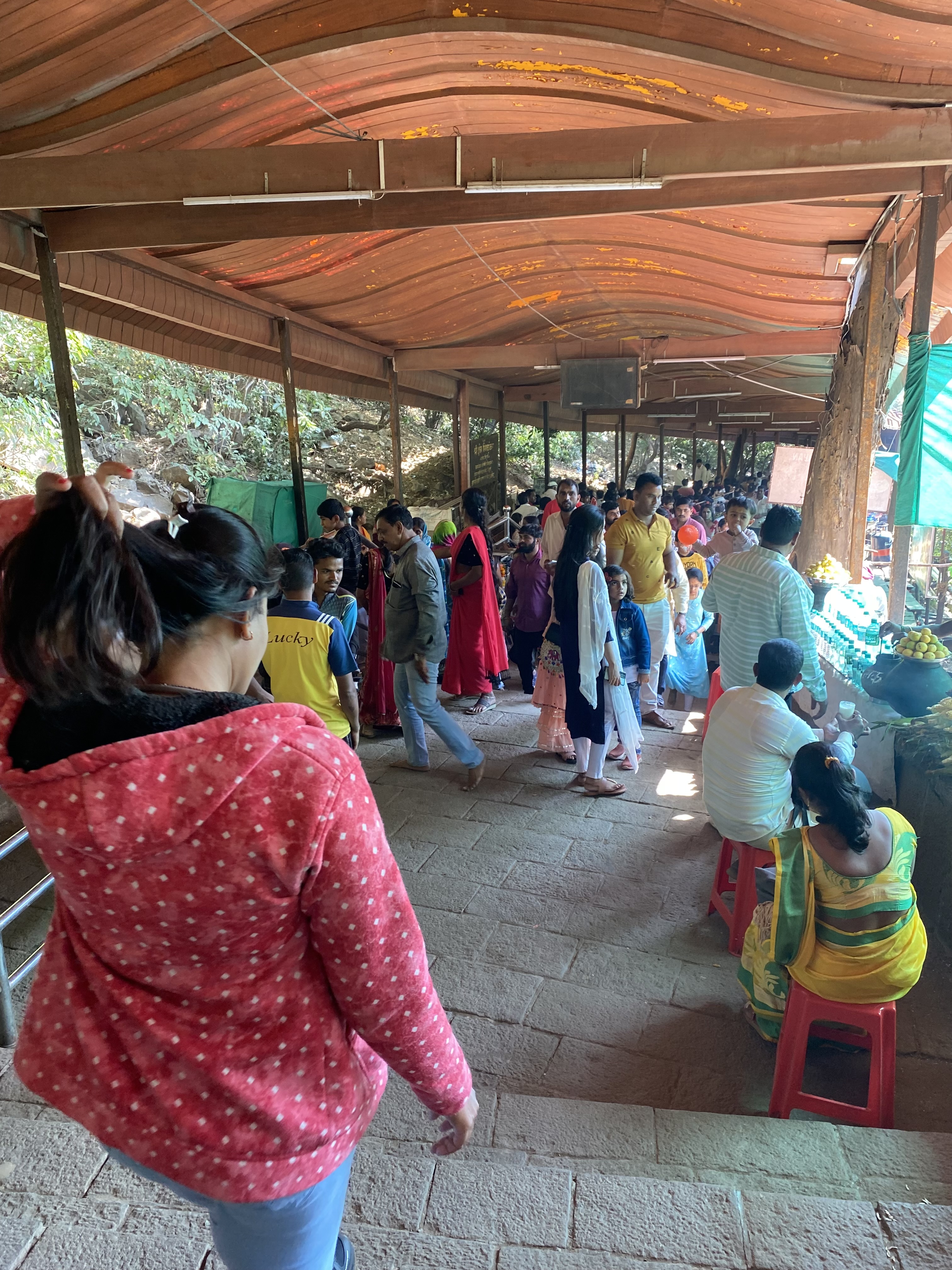
There was a fairly long line for common darshan. We preferred to have the special darshan, cost for which is Rs.500 per head. As we moved forward towards the ticket counter, we were accosted more than once by agents (Good Samaritans?? ) who promised us a quick darshan without having to buy tickets, of course for a price. Ignored them and went to the ticket counter and bought the tickets. The person at the counter was initially reluctant to issue the tickets but had to, and indicated to the sentry at the gate to allow us in. There is a fine racket run by the ticket counter clerks, the agents and the sentries who would allow people for special darshan without tickets by possibly charging a slightly lower amount, which they would share.
Special darshan was anything but special as it took us a good one hour plus in the queue. The queue was at an extended part of the temple i.e. the assembly hall (said to have been in the 1960s) and we soon entered the main old temple. Built in various phases, the oldest part of the temple built in the Nagar style of architecture, dates back to the 13th century CE. Other portions of the temple are stated to have built around 1437 AD and renovations carried out during the Peshwa regime by Nana Phadnavis.
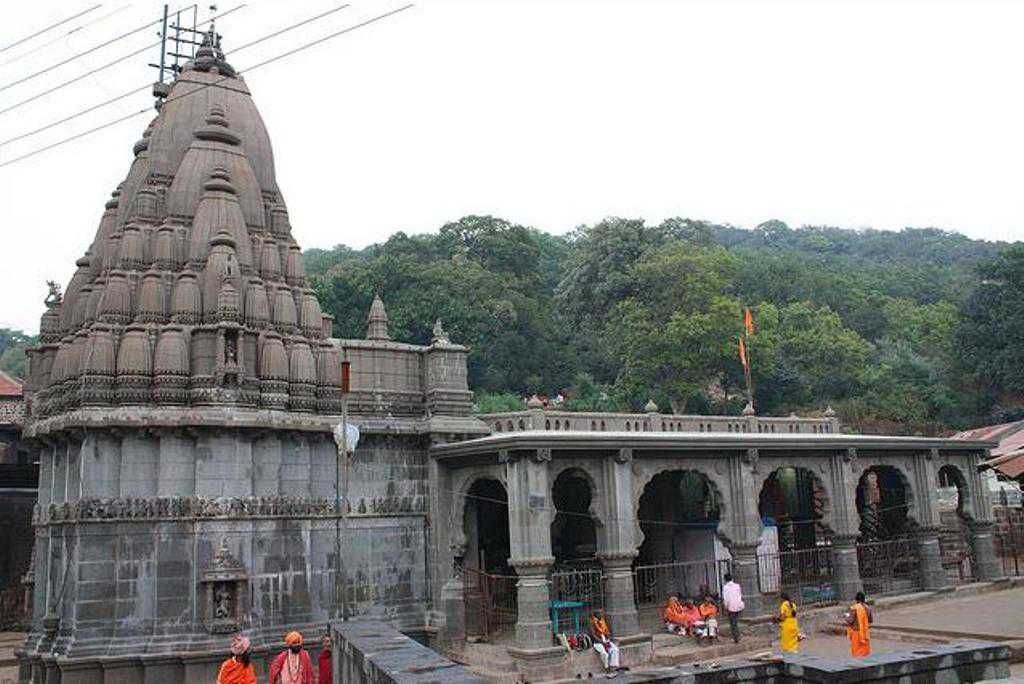
Passing the moorthis of Ganesha, Hanuman & Krishna, we were right outside the sanctum sanctorum besides the Nandi.
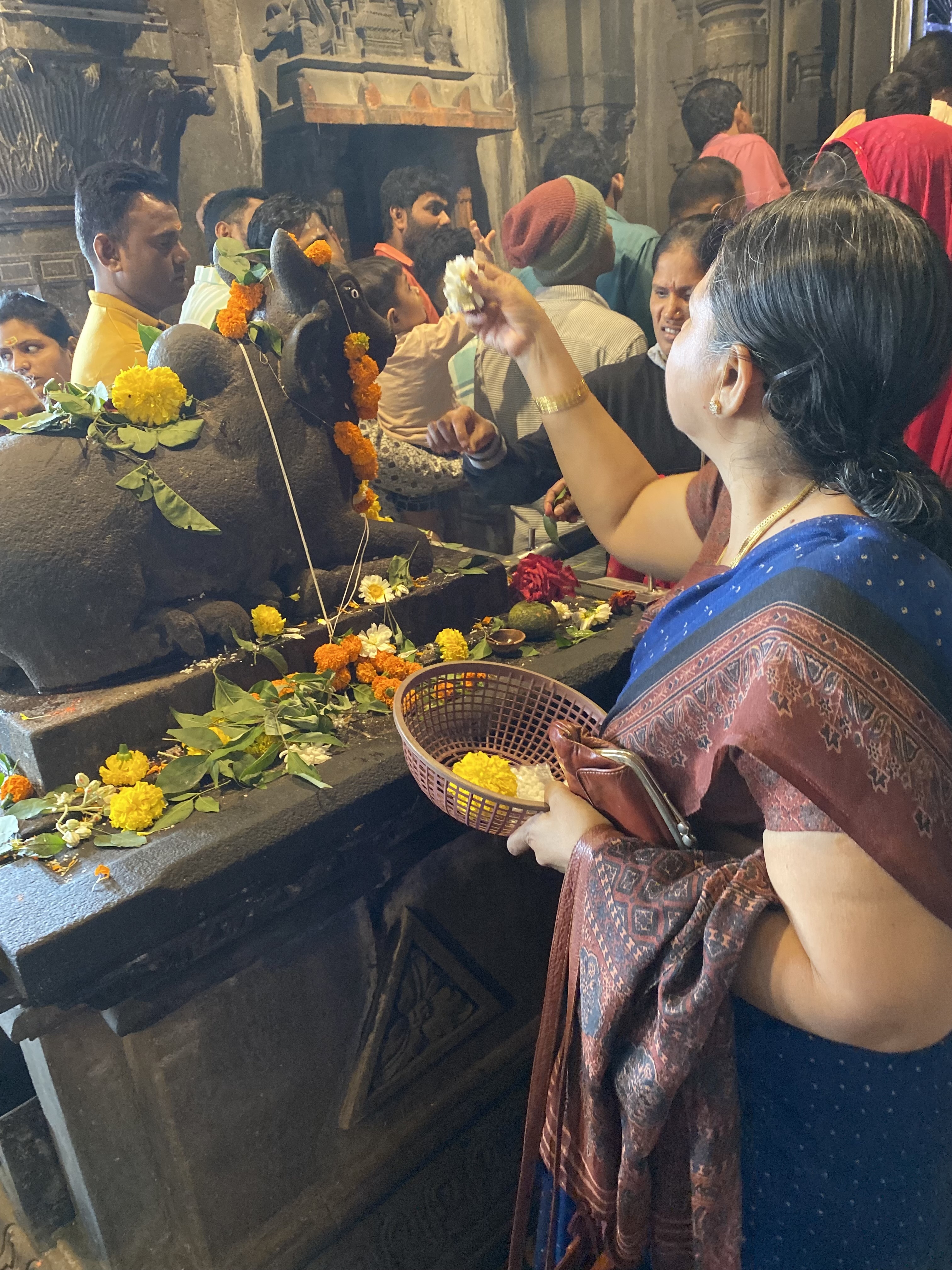
Now we were inside the sanctum sanctorum which is at a lower level and one has to climb down a couple of steps. We are allowed to touch the lingam which is at the center. There is said to be a vertical hole in the jyotirlinga, with its two sides representing Shiva and Parvathi ( Ardhanari). We prayed and made a token cash offering, when the priest whispered to us that for another Rs.500, we could do a milk abhisheka. Frustrated at this crass commercialism, we thanked him, refused and came out.
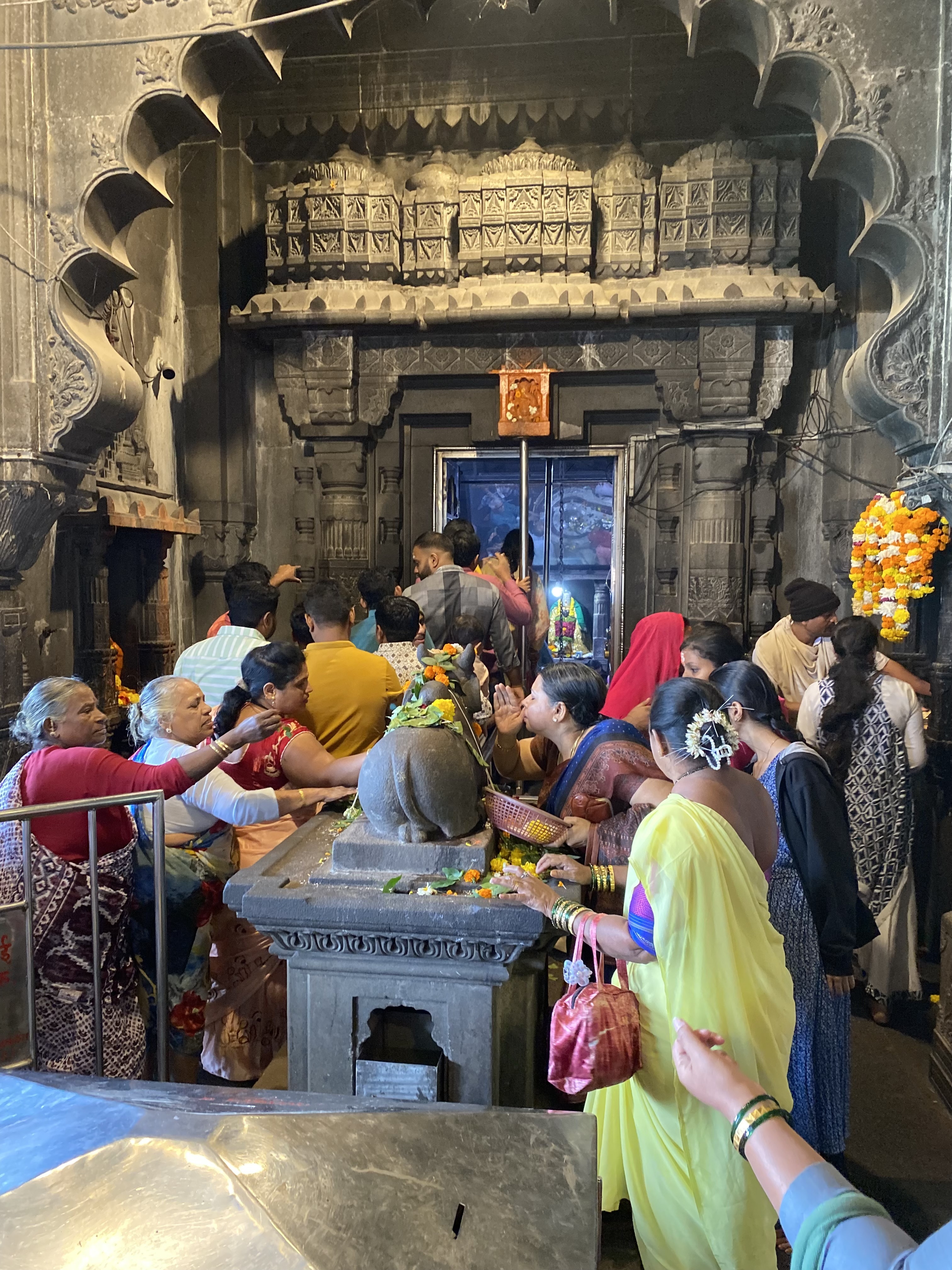
Coming out after darshan of the jyotirlinga, next was the shrine of Shaniswara inside the temple complex. We were informed that the shrine of Kamalja Mata (consort of Lord Bhimashankar) was situated a short distance away outside the complex, which we did not visit. In the courtyard of the temple, there are two Nandis. No one was able to explain why. My gut-feel is that the two were installed over different time periods. One could see disciples whispering in the ears of both the Nandis and of course ……… clicking pictures.

Other interesting sights in the courtyard included a huge bell which is said to have been gifted by Chimaji Appa after his victory over the Portuguese in Bassein ( modern-day Vasai). The bell was transported here from the Bassein fort. Also seen in the temple floor is a tortoise made of stone.
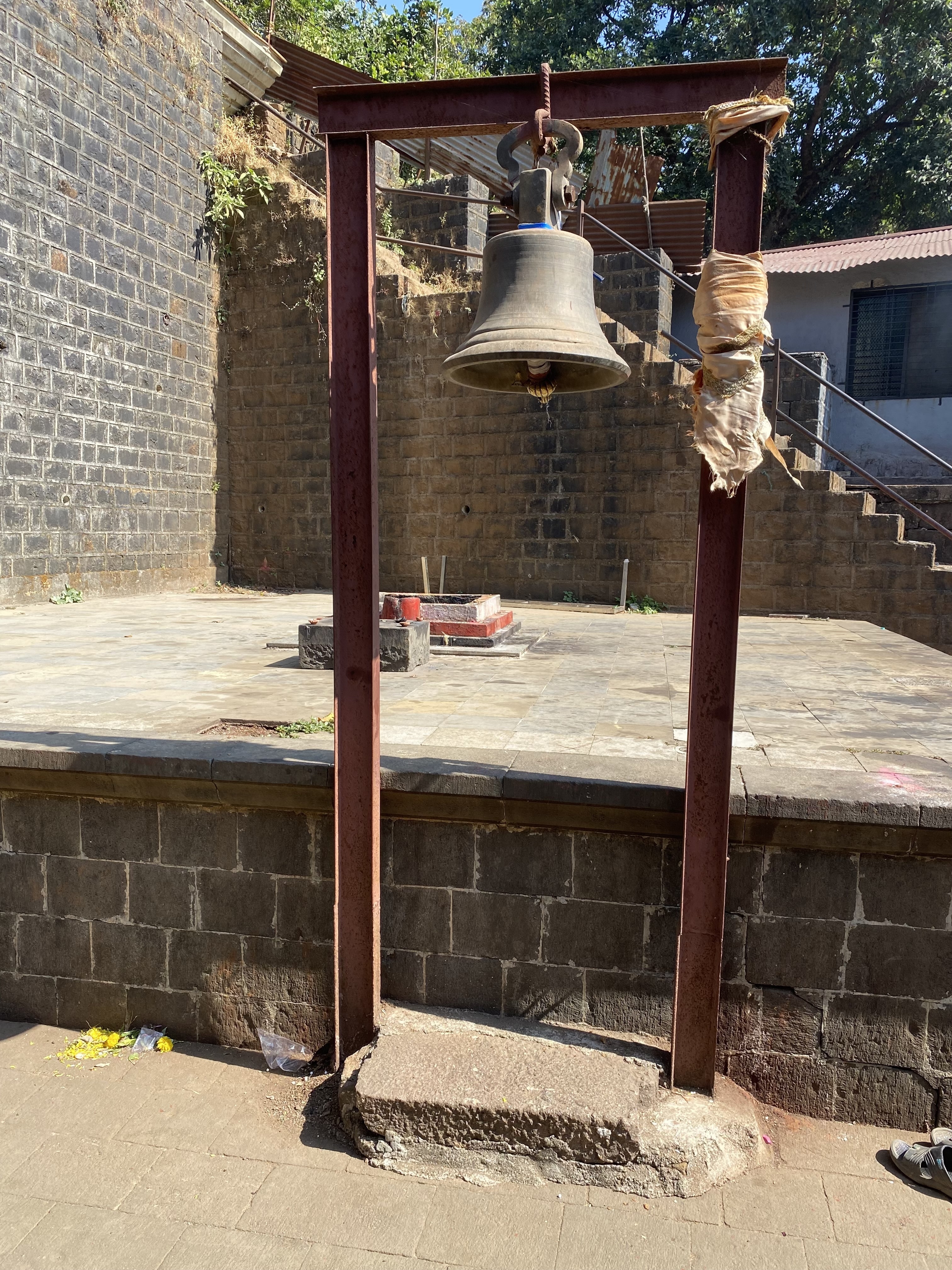
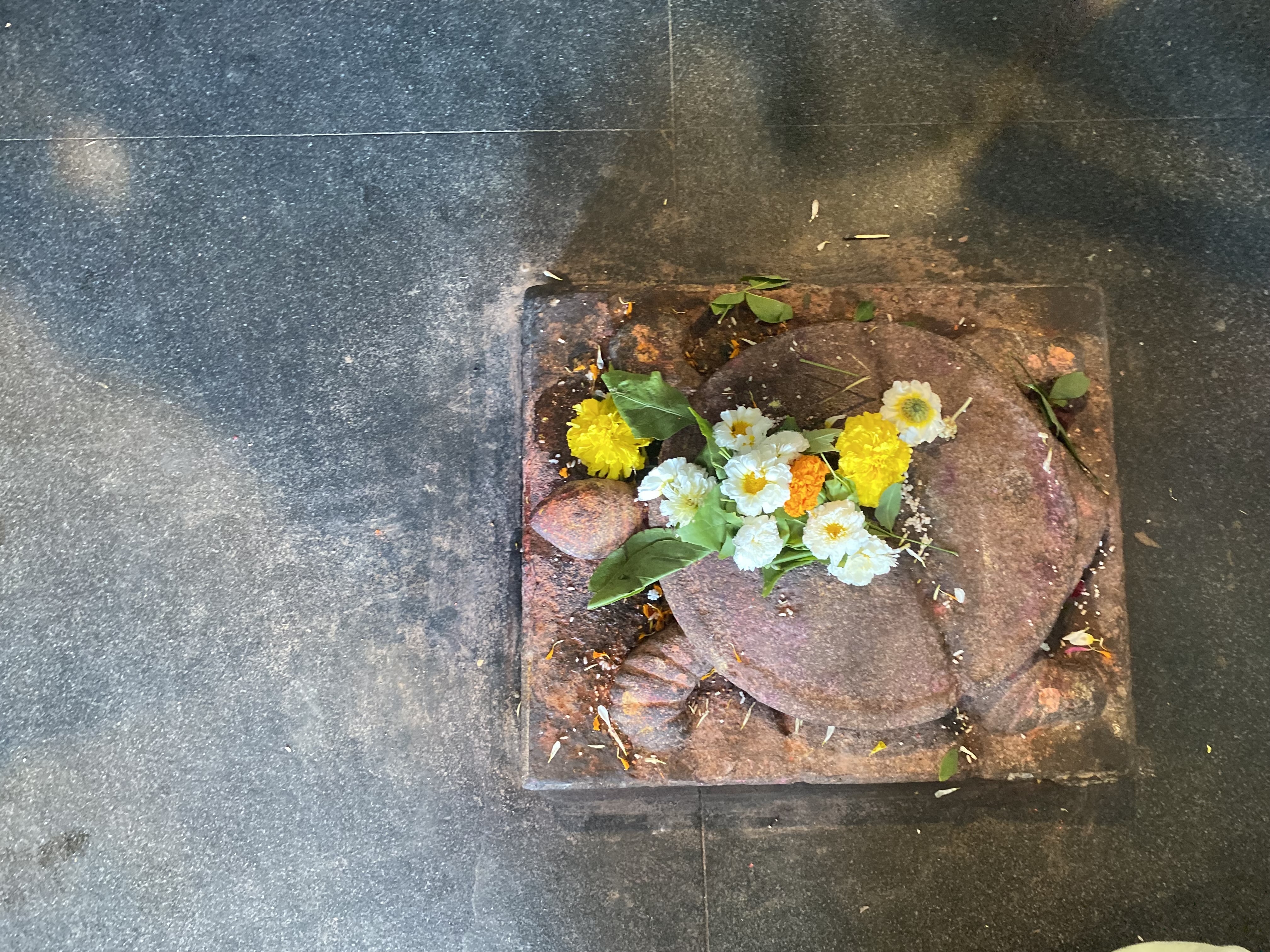
Began our long climb back to the road level. Yes, you climb down to the temple and climb up on the way out. Extremely thirsty, we stopped at a roadside stall for ‘nimbu paani’. It tasted like manna from Heaven. Asked the lady of the stall about ‘ Gupt Bhima’ which is said to be the source of the Bhima river . She mentoned that one has to walk through the forest with a guide for around three to four kilometers and the round journey would take around 3 hours. We said, forget it. Incidentally, Bhimashankar is very popular with trekkers who have different routes through the forest to reach the temple. The entire area is a reserve forest and a sanctuary for the State animal of Maharashtra, the ‘Shekru’ or the Giant Indian squirrel. Did not see one though, as we did not venture into the forest.
Had heard of some excellent viewing points from here behind the bus-stand. The place had been fenced off, obstructing the view and all that remained was the strong stench of urine. It was close to 2 PM. We walked to our car and with great difficulty turned it around on the narrow road. Now cars were parked on the opposite side too. As we inched our way out of Bhimasankar, we could now see cars lined up on the roadside for more than 3 kilometers. Imagine the trouble pilgrims/tourists will have if they were to walk long distances or fall prey to the ‘ motorbike agents’. The powers-that-be should immediately focus on creating more parking spaces at Bhimasankar or on the adjoining open land and collect parking charges from motorists for the same. If the Government is serious about promoting religious tourism, this must be attended to, on priority. Rid the area of touts.
We were ravenously hungry. Stopped at a small open-air restaurant or was it a homestay? Almost all eateries in this area serve only vegetarian food. We had piping hot tandoori rotis, dal, vegetables and chaas. Of course, it must be mentioned that the food was spicy, a hallmark of this region. Need to inform in advance, I guess, to go easy on the chilies.
3 PM, we began our descent from the abode of Lord Bhimasankar and the return journey was largely uneventful. Stopped to catch the beauty of Dimbhe Dam down below in the valley across the Ghod river, shimmering in the bright sun.
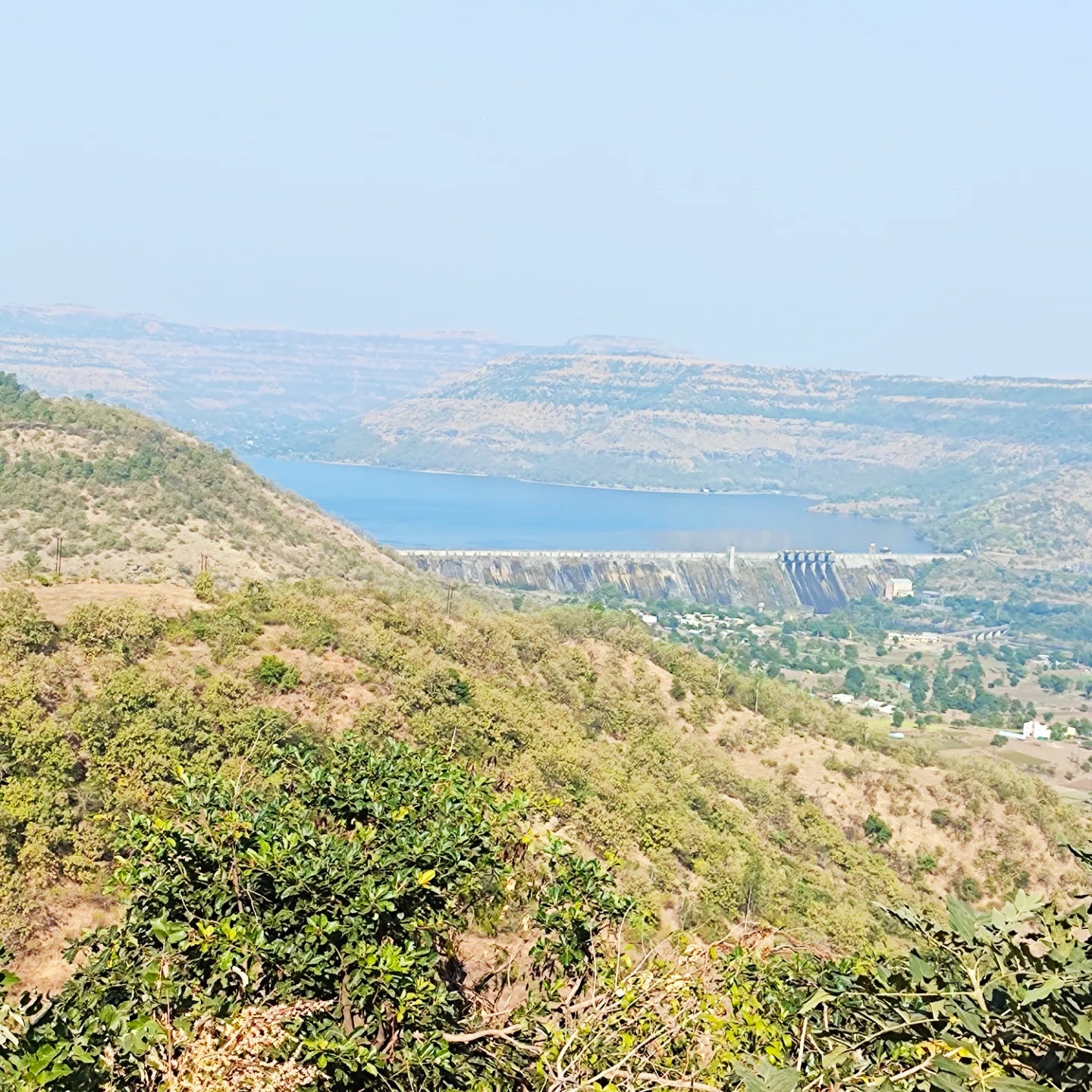
We have been residing in Mumbai for more than 25 years and it was only now that we have darshan of Bhimasankar which is just 220 kilometers away. Maybe the Lord willed it that way. Jai Bhimashankar!
Discover more from BalasBroadcast
Subscribe to get the latest posts sent to your email.
Loved the write-up. The first version of BhimaShankar reminded me very much about Bhasmasur, another gentleman who was also given a similar boon of eternal life by Shiva. Nothing ever would kill him except when he touches his head with his own hand. When Bhasmasur started to run amok with the newfound power, Shivji took the avatar of an enchantress Mohini and tricked him into touching his head with his own hand and thus burning himself up. Wasn’t one mistake with Bhasmasur enough that he had to do with the other one too?
Though I am not a regular reader of religious articles, I enjoyed your this article well written and vividly described. Looking forward to more such articles from you.